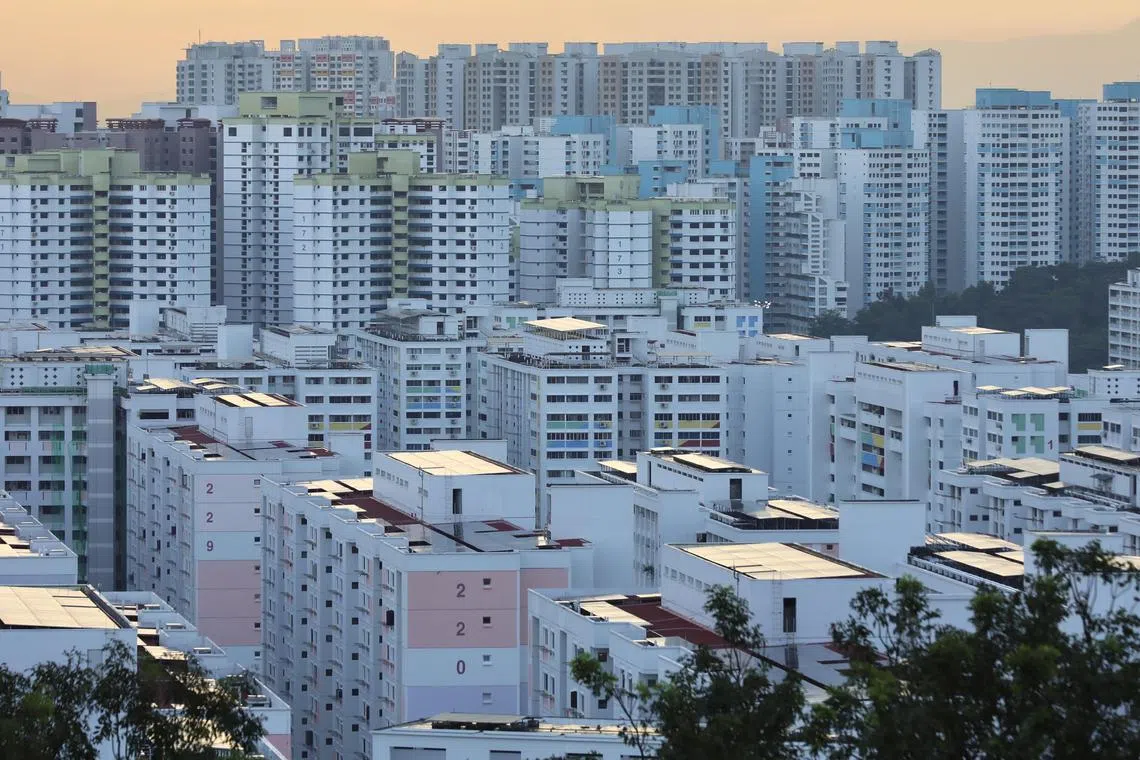1 in 4 appeals to waive HDB wait-out period for private home owners approved since Sept 2022
Sign up now: Get ST's newsletters delivered to your inbox

The 15-month wait-out period was part of a series of measures introduced to help cool the HDB resale market.
ST PHOTO: TARYN NG
Follow topic:
SINGAPORE - About one in four appeals from private property owners seeking to bypass the 15-month wait-out period to buy a Housing Board resale flat has been successful, the Housing Board said.
From the time the rule was introduced on Sept 30, 2022, until March 31, 2025, HDB received and processed about 5,500 appeals for a waiver. Around 25 per cent of these were approved after careful assessment of each case.
Extenuating circumstances of the flat buyers and their families are taken into account “to ensure that applicants and families with genuine needs are given fair consideration”, a spokeswoman for HDB told The Straits Times.
When asked, the HDB did not specify the typical reasons cited in appeals and the criteria used to assess them.
The 15-month wait-out period was part of a series of measures introduced to help cool the HDB resale market
It also helps to prioritise public housing for Singaporeans with more urgent housing needs, HDB said.
The rule applies to private property owners and former owners looking to buy a non-subsidised HDB resale flat. It does not apply to those aged 55 and above who are buying a four-room or smaller resale flat.
National Development Minister Chee Hong Tat said recently that the rule may be relaxed before 2027
The HDB spokeswoman said there are early signs of moderation in resale price growth. “We expect the market to further stabilise as more flats reach the Minimum Occupation Period (MOP) and enter the resale market over the next few years starting from 2026,” she said.
“We will also maintain a strong supply of Build-To-Order (BTO) flats to meet housing demand.”
Shift in demand patterns
Since the rule took effect, analysts have noted a marked impact on the resale market, particularly on larger flats.
Mr Mohan Sandrasegeran, head of research and data analytics at real estate firm Singapore Realtors Inc, noted that the number of five-room flats resold dropped by 22.5 per cent to 1,482 units between January and March 2025, compared with 1,913 units resold from July to September 2022, just before the 15-month wait-out period kicked in.
Executive flats saw a steeper dip of 32.1 per cent in transactions between the two periods.
The figures suggest that the wait-out rule has helped dampen demand from private property downgraders to some extent, said Mr Mohan. He added that the latest flash estimates for April to June 2025 released by HDB on July 1 showed resale flat prices continuing to moderate, rising by 2.5 per cent in the first half of 2025 compared with 4.2 per cent in the same period in 2024.
While the rule has helped cool demand, some private home owners facing unexpected life changes – such as job loss or financial strain – could benefit from more flexibility, said property analysts.
Mr Eugene Lim, key executive officer of real estate agency ERA Singapore, said the HDB resale price index (RPI) slowed after the 15-month wait-out rule took effect on Sept 30, 2022, but picked up once eligible private home sellers re-entered the market in the first quarter of 2024.
Resale transactions rose to 7,068 units from January to March 2024, with the RPI climbing 1.8 per cent quarter on quarter. The index rose another 2.3 per cent in the second quarter of 2024, which was close to the 2.6 per cent gain seen in July to September 2022 before the rule was introduced.
Growth eased to 1.6 per cent in the first three months of 2025
He has also observed that price growth in the HDB resale market has been increasingly driven by buyers favouring newer flats with longer remaining leases.
This preference, especially among home owners looking to move to a flat that better suits their needs, has led to a divergence in price trends between “younger” and “older” flats.
The agency’s analysis showed that unit prices of newer flats – typically, those under 25 years old – have seen stronger appreciation compared with those of older flats.
Mr Lim said lease decay concerns among home buyers have contributed to the faster appreciation for newer units, which are often priced at a premium. Lease decay is the erosion of a flat’s value as the end of its 99-year lease approaches.
He added that such buyer behaviour is independent of any possible revision to the 15-month wait-out policy, and he expects it to remain a key driver of overall price trends.
Between 2025 and 2027, more than 50,000 flats will be launched
More flats will also hit the market as they complete their MOP – a mandatory stay period (typically five years) before owners are allowed to sell them on the resale market.
About 13,500 flats will reach their MOP in 2026, up from 8,000 in 2025. In 2028, this will rise to 19,500 flats.
Mr Chee said he expects that the effect of a strong continued supply of new BTO flats and resale units would moderate resale prices, making it timely for the authorities to consider if the 15-month cooling measure should be partially or entirely removed.


